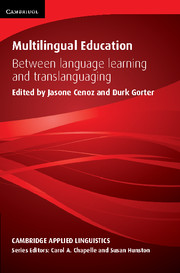Book contents
- Frontmatter
- Contents
- List of contributors
- Series editors’ preface
- Acknowledgements
- 1 Towards a holistic approach in the study of multilingual education
- 2 L1 as a pedagogical resource in building students’ L2 academic literacy: pedagogical innovation in the science classroom in a Hong Kong school
- 3 Linking content, linking students: a cross-linguistic pedagogical intervention
- 4 The role of the native language in the literacy development of Latino students in the United States
- 5 A nexus analysis of code choice during study abroad, and implications for language pedagogy
- 6 Multilingual practices in foreign language study
- 7 Language choices and ideologies in the bilingual classroom
- 8 Communicative repertoires in the community language classroom: resources for negotiating authenticity
- 9 Complementary classrooms for multilingual minority ethnic children as a translanguaging space
- 10 Constructing in-between spaces to ‘do’ bilingualism: a tale of two high schools in one city
- 11 Becoming multilingual and being multilingual: some thoughts
- Index
1 - Towards a holistic approach in the study of multilingual education
Published online by Cambridge University Press: 17 September 2021
- Frontmatter
- Contents
- List of contributors
- Series editors’ preface
- Acknowledgements
- 1 Towards a holistic approach in the study of multilingual education
- 2 L1 as a pedagogical resource in building students’ L2 academic literacy: pedagogical innovation in the science classroom in a Hong Kong school
- 3 Linking content, linking students: a cross-linguistic pedagogical intervention
- 4 The role of the native language in the literacy development of Latino students in the United States
- 5 A nexus analysis of code choice during study abroad, and implications for language pedagogy
- 6 Multilingual practices in foreign language study
- 7 Language choices and ideologies in the bilingual classroom
- 8 Communicative repertoires in the community language classroom: resources for negotiating authenticity
- 9 Complementary classrooms for multilingual minority ethnic children as a translanguaging space
- 10 Constructing in-between spaces to ‘do’ bilingualism: a tale of two high schools in one city
- 11 Becoming multilingual and being multilingual: some thoughts
- Index
Summary
Multilingualism at school as a global phenomenon
Although multilingualism is not a recent phenomenon, it has become more common in recent years due to globalization, transnational mobility of the population and the spread of ICT. According to Aronin and Hufeisen ( 2009 ), contemporary multilingualism has spread geographically and socially and is characterized by the use of languages that are not originally from neighbouring areas. Furthermore, technology has contributed to instantaneous communication among multilingual speakers in different parts of the world. The statistics on the use of English and other languages on the Internet show that multilingualism is increasing. English is still the most widely used language on the Internet. It was used by 51.3% of internet users in the year 2000 (Graddol, 2006 ), but this figure dropped to 26.8% in 2011 (Internet World Stats, 2011 ). Meanwhile, the use of other languages such as Arabic, Chinese and Russian is growing much faster than the use of English on the Web (Internet World Stats, 2011 ). Globalization has given multilingualism not only visibility but also an added value associated with the ability to speak several languages (Edwards, 2004 ).
Multilingualism at the individual level (also referred to as plurilingualism) brings together the process of acquiring second or foreign languages and the use of these languages. Individuals may learn and use languages of wider communication such as English or Mandarin, but they may also learn languages used in their sociolinguistic environment. Multilingualism can give better opportunities, particularly in the job market, but it is also linked to identity and belonging to one or more speech communities. The latter is often the case with less spread languages, such as Maori in New Zealand, Basque in the Basque Country or Welsh in the UK. Speakers of these languages are usually fluent in international languages (English in the case of Maori and Welsh, French and/or Spanish in the case of Basque), but they go on using their own languages.
Multilingualism has spread in education and nowadays it has more visibility in school settings. Many schools in different parts of the world have second or foreign languages as part of the curriculum.
- Type
- Chapter
- Information
- Multilingual EducationBetween Language Learning and Translanguaging, pp. 1 - 15Publisher: Cambridge University PressPrint publication year: 2015
- 36
- Cited by



